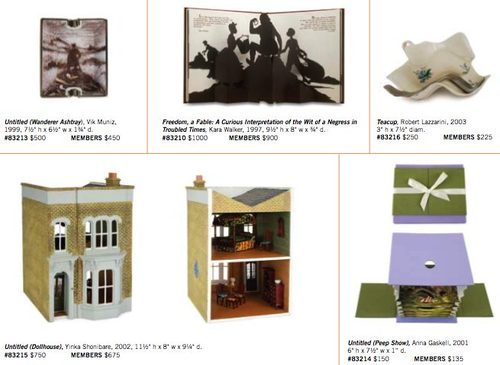Score one for the bloggers. I found this beautiful little packet of souvenir photographs at a small, otherwise uninteresting flea market a few weekends ago.
They're tiny, just 2x2.5 inches, but they're crisp and beautiful in a way that reminds me we're losing something tangible in this wholesale shift to digital printing.
The photos reminded me a bit of a miniature photogrid from Olafur Eliasson--he's done caves looking in and looking out, and some later pieces are documentations of his trip through a place, like the river rafting series.
But more than that, they reminded me of a tiny set of Robert Smithson mirror displacement photos I kind of wanted to buy. Smithson had used a Kodak Brownie to take tiny, square snapshots of mirrors stuck in the snow on his Greenwich Avenue roof. The Met had them on hold for a very long time, and ended up taking them in 2001. There are no images online, but they fall in an interesting place in Smithson's work, between his contact sheets and his rarer, larger photos.
As for these photos, I have to thank Steve Roden, who helped me notice them at all. Roden had posted this summer about the Luray Caverns, specifically a recording of The Great Stalacpipe Organ, which was made of concert-tuned stalactites. Those Luray promoters didn't miss a single angle.
October 2009 Archives
October 31, 2009
The Beautiful Caverns of Luray, Virginia
October 31, 2009
What I Looked At Today - Mondrian Transatlantic Paintings
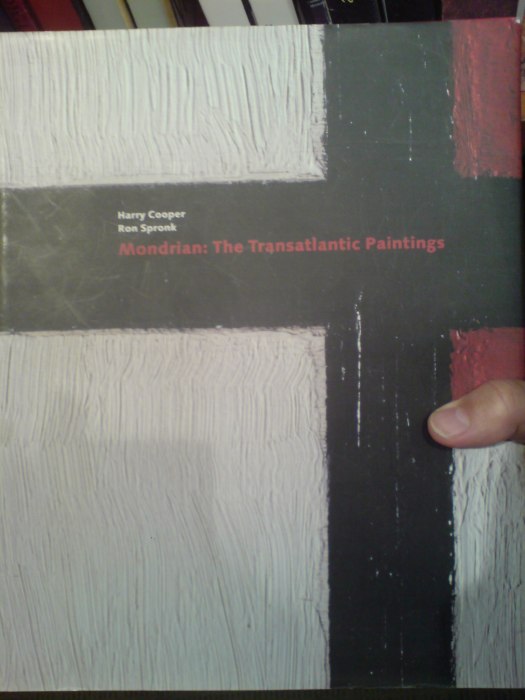
Anyone with an interest in Piet Mondrian's painting technique probably already has Mondrian: The Transatlantic Paintings, published by the Harvard Art Museums in 2001. It's a fascinating, in-depth, and not-at-all boring look at a unique body of Mondrian's work, based on the scholarship of art historian Harry Cooper and forensic painting scientist Ron Spronk.
They examine a group of 17 paintings which Mondrian took with him to New York when he fled Paris just before the outbreak of WWII. Mondrian had already shown some of the paintings, but he reworked them so significantly after his arrival in the US, that he gave them all two dates. [The Phillips Collection's Painting No. 9, for example is dated 1939-1942.]
Cooper and Spronk get deep into the layers of paint to reveal how Mondrian constructed and executed his paintings, and then how he altered them. It's great, geeky stuff, and the book is filled with weird, interesting photos of details--like 40x zooms on brushstrokes, and the messy backs and reshaped stretchers--that people who don't own Mondrians never get to see. And there's X-ray photos and spectral analysis that you usually only see used on Old Masters, rarely on modern art. These images, these paintings, are objects, after all, and they were made by someone. It's a basic reality that is somehow easy to forget.
Buy Mondrian: The Transatlantic Paintings for like $40, a third off the $60 cover price [amazon]
October 30, 2009
What I Looked At Today: Theo van Doesburg Edition
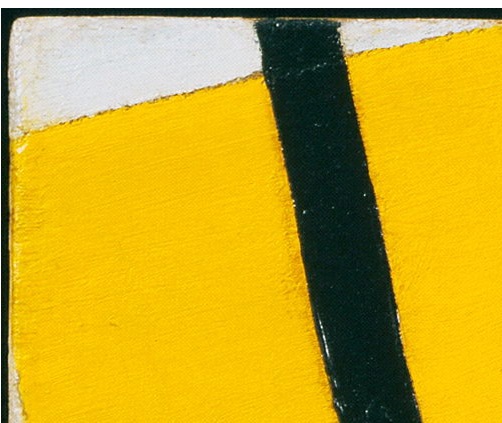
It's hard to see Theo van Doesburg's work up close these days, especially paintings. But for this Dutch Landscapes paintings project, the technical and theoretical logic of both Mondrian and van Doesburg is pretty inarguable.
Though the de Stijl folks were pursuing geometric purity and truth, not deploying abstraction as an obscuring, information-smothering blanket, the boundaries of their color planes and lines are interesting reference points.

And fortuitously, a new, expansive exhibition of van Doesburg and his network of influence across the avant-garde, just opened at the Stedelijk Museum De Lakenhal in Leiden. It will travel to the Tate Modern in February. Which is as convenient an occasion as any for the release of a beautiful hi-res image of Simultaneous Counter-Composition, 1929-30, which is on loan from MoMA's collection. Just look how the yellow brushstrokes come up right against the black line. And the free edge on that little white wedge up there,
October 29, 2009
The Knew Museum
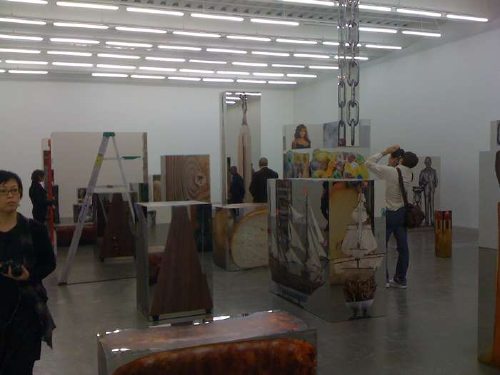
At the press preview of the New Museum's Urs Fischer show yesterday, curator Massimiliano Gioni said that Fischer "treats reality as if it were software," an assessment I suspect is designed to be tweeted more than analyzed.
Gioni and Fischer are entitled to use any metaphor they care to, of course, and this artist-as-reality-coder trope may be borne out nicely in the scholarly catalogue essay. But it also the kind of cross-disciplinary conceptual appropriation that leaves itself open to mockery by people who actually know what they're talking about, like how NYU physicist Alan Sokal submitted a nonsensical paper, "structured around the silliest quotations [he] could find about mathematics and physics" made by postmodernist academics which questioned the hermeneutics of quantum gravity, to the cultural studies journal Social Text--who published it without question or peer review.
But looking at the work, Gioni's explanation may turn out to be less deep but more valid than it first seems. The "Labyrinth of Mirrors" on the second floor, for example [above, in a photo from @artnetdotcom], is full of four-sided pictures of objects on mirrored boxes, which distort the space of the room as you walk around them. They feel like real-world approximations the XYZ-grid boxes inhabited by irregularly shaped virtual objects in Google Sketchup or the CAD/CAM programs. Which makes Fischer a user, not a coder.
Spatially, they labyrinth also gives off a bit active camo/invisibility vibe, like James Bond's Aston Martin in Iceland, or--yes, it seems I have to go there--The Matrix.
So the world we see is just a construct, all ones and zeroes, and we're too asleep to know it. Or the digital worlds where we increasingly spend our time--Google Earth, Halo, Second Life [oh wait, that's right, no one actually does Second Life]--are rapidly eating away the physical world's monopoly on reality, confounding our expectations and perceptions along the way. Maybe it's all making too much of a throwaway soundbite.
One thing I'm sure of though, is that Rotterdam architect Roeland Otten finished his trompe l'oeil Transformatie project just in time. [via]
October 28, 2009
Autoprogettazione Updates From All Over

Sheesh, as if I wasn't painfully aware of the nearly finished Enzo Mari x Ikea Mashup table sitting behind my sofa, I get this, from Peter Nencini, [above] which frankly just hurts:
A couple of weeks ago we reassembled 32 studio tables, originally built last year to Enzo Mari's Autoprogettazione plans, published in 1974.I'll assume that they're not putting twelve coats of hand-rubbed tung oil on theirs. At least I can hope my next 31 tables will go much more quickly.
Then there's Wallpaper magazine swooping in with Autoprogettazione Revisted at the Architecture Association in London, where AA students and a few name designers show off their Mari-inspired hacks, and there's even a lecture by Mari himself, which is alternately animated and tedious, and thanks to the on-the-fly translation, twice as long as it would normally be.
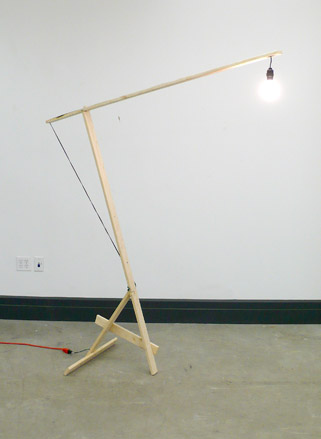
But even as I worry a bit about missing a trend--or worse, finding myself caught up in one--I'm reading the AA's catalogue and instructions for the show--because yeah, I'd totally make Kueng-Caputo's awesome lamp, wouldn't you?--and I find this:
Mari was ultimately disappointed with the original response to Autoprogettazione, believing that 'only a very few 1 or 2% understood the meaning of the experiment'...Enzo Mari hoped that the idea of Autoprogattazione would last into the future. Autoprogettazione Revisited reveals that it has done just that. Not all of the artist/designer responses in Autoprogettazione Revisited can be duplicated by the enthusiast, but they are inspirational and without a doubt follow the Mari principle that 'by thinking with your own hands, by [making] our own thoughts you make them clearer.'I've always understood Mari's project to be a critique of the self-important distinction between the "artist/designer" and the "enthusiast." In his lecture, Mari actually said that of the many thousands of requests for Autoprogettazione plans, only 1-2% of them were from design professionals. I can totally imagine the head of an architecture school gallery thinking that those two tiny, so-enlightened populations are the same, but I'm not at all sure Mari would agree with her. [thanks andy for the links]
October 28, 2009
Korean Art Flipper Eats It On Schnabel Dog
It happens all the time in the Old Masters market, but I could never understand how a work of art could sell at auction for one price, only to reappear--and to sell--at a fair a few months later with a vastly inflated price tag. I mean, I can imagine how a dealer would do it; and if there were a cleaning, a restoration, a different presentation, or even new research or a new attribution, it can even make sense. What I don't get is the mindset of the collector who, either through indifference or ignorance, buys a work that just sold very publicly for 40-80% less than what he paid.
Of course, it would explain a lot if these chumps are all North Korean 80's art speculators. Let's pick at some of the confusing details from the New York Law Journal's error-ridden story of an unsuccessful lawsuit by one such "collector," Najung Seung, who the NYLJ describes as "a resident of North Korea" and "a woman who worked in art galleries in Beijing."
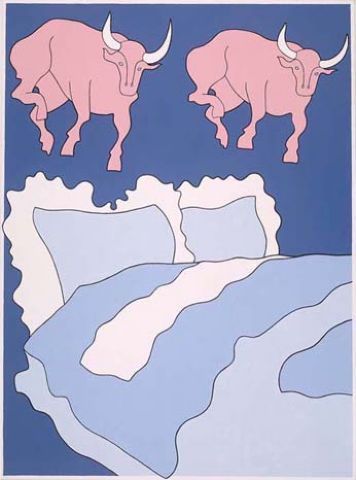
In May 2006, Seung, and who is actually listed in court filings as Korean, not North Korean, bought a 1986 John Wesley painting for $118,000 from Dinaburg Arts, a NY art advisory. Its principal, Mary Dinaburg, had just curated Wesley into the windows of the Hermes store, and Seung was friends with one of Dinaburg's assistants.
But despite holding a paid invoice for Bulls and Bed, "the following March [i.e., 2007], Seung learned that Dinaburg had sold the Wesley painting to another buyer," reportedly for $200,000. Way to stay on top of things, Najung. [Bulls and Bed was at Basel this past summer, btw, offered by Wesley's London representative, Waddington Galleries, for $300,000. It's still available.]
To make up for it, Dinaburg apparently offered Seung a $200,000 credit toward the purchase of Chinkzee a giant, truly execrable, 1983 velvet painting of a dog by Julian Schnabel. It was a $500,000 painting, Dinaburg said, though she'd let it go at the "gallery net" price of $380,000. In a May 2008 email, Dinaburg wrote, "I believe we have a good opportunity to place your work within the year and resell it a profit."

Instead of her main firm, though, Dinaburg offered the Schnabel through Fortune Cookie Projects, [not Ventures, NYLJ. Who's proofing these things?], the Asia-focused art advisory operation she'd launched in 2006 with Howard Rutkowski, who oversaw Asian, modern, and contemporary art for Bonham's auction house in London.
Seung agreed and paid Fortune Cookie an additional $90,000 in June 2008. Her lawsuit mentions a final invoice [presumably unpaid] for the last $90,000 installment, dated October 30, 2008, aka The End of The Art World As We Knew It.
At some point--even though it kind of matters, it's not clear when--Seung realized that Chinkzee had sold in May 2007 at Phillips in New York for $156,000, well above its original estimate of $60-80,000, but well below the $500,000 value she'd been told. [How Seung managed to avoid getting those gigantic catalogues Fedexed to her, I have no idea; Phillips was blanketing the globe with those things.]
Anyway, if Seung's case is meaningful, it's only as a reminder to collectors to do their own damn homework; the NY Supreme Court determined that art advisors and even dealers are not "experts," and their opinions are just sales patter which constitutes, at best, "non-actionable 'puffery'...on which a sophisticated commercial entity could not reasonably rely."
When I started writing this post, I thought it was just a savvy dealer using the promise of an easy follow-on flip to flip her own auction purchase to a clueless, foreign speculator. But there's someone else involved. Dinaburg's emails to Seung, including the one promising "the gallery net," make it sound like Chinkzee was coming from the artist himself:
(1) We are working with the very well respected [sic] and important [sic] artist Julian Schnabel. I was thinking that I could offer you what I offer the galleries directly...Did Schnabel buy his own old painting back from Phillips, and then flip them back through Fortune Cookie? Or was Chinkzee just part of Fortune Cookie's big, 2007 All-Asia Tour of Schnabel's "best works"? [A: Yes.] There is a punchline here somewhere about sarong-wearing white devils peddling Chinkzees out of the back of a Fortune Cookie van as they drive across China, but I can't figure it out.(3) I have spoken to the Schnabel studio and have gotten the final lowest possible price on both [?] works
(4) I was over there with Julian before I went to Hong Kong and we were pricing work and you will never see a Schnabel form [from] the studio coming out at the prices they are now, but higher.
No Money Back for Gallery Worker Who Relied on Estimate of Schnabel Painting's Value [law.com]
Sept. 2007: Julian Schnabel Presents Best Works in Beijing [china.org.cn]
From the Other Things I Didn't Know About What Goes Inside Geodesic Dome Pavilions Department:
Christine Macy and Sarah Bonnemaison devote a chapter in their 2003 book, Architecture and nature: creating the American landscape to geodesic domes, including this description of Buckminster Fuller's original vision for the US Pavilion at Montreal's World Expo 67:
His [Fuller's] design of 1964 featured a dome nearly twice the size [of the 250-ft diameter, 3/4 dome by Fuller and Shoji Sadao that was realized] with a massive interior gallery. From this elevated vantage point, the viewer would focuse their attention inward to a hundred foot diameter Earth tranforming slowly into an icosahedron, before it opens up, unfolding like a flower as it descends to the floor. [what a sentence. -ed.] In this way, Fuller's "geodesic" globe transforms into his "Dymaxion" map of the Earth before the visitors' eyes, displaying the "one world island in one world ocean." And then it would come to life. Wired with tens of thousands of miniature light bulbs, this great map would begin to pulsate with patterns--showing world resources, electricity generation, the flow of transportation and communication systems across the Earth. This interactive display, this giant bio-feedback device, would be the playing surface of the "World Game." Assembling in teams or playing by themselves, visitors were intended to chart out optimal paths to link resources with industries and population centers, to streamline transportation flows and maximize satellite coverage The aim, according to Fuller, was to "make the world work successfully for all of humanity...without anyone gaining advantage at the expense of another."Since he had not actually been asked to design the exhibit, just the pavilion, this idea was rejected and replaced by a selection of quilts, duck decoys, and Cary Grand billboards.
October 27, 2009
American Painting Now Then

How to account for my dogged fascination with the temporary/permanent, futuristic/historic paradoxes of Expo art and architecture?
Buckminster Fuller's 20-story Biosphere was far and away his greatest single success and the hit of the most successful modernist world's fair, the Expo 67 in Montreal. And yet how little did I consider what was in it: a giant exhibit of the movies; The American Spirit, an exhibit of NASA satellites and space capsules; some crafts or whatever, and American Painting Now, 23 huge paintings commissioned by Alan Solomon from a "Who's Who of modern art," including :
James Rosenquist, Claes Oldenburg, Andy Warhol, Jasper Johns, Jim Dine, Ellsworth Kelly, Barnett Newman, Robert Rauschenberg and Roy Lichtenstein. Their works illustrated trends such as abstract expressionism, op, pop, hardedge and geometric art. Like the space component, this part of the American exhibition was truly spectacular. The works, gigantic, simple and colourful, paid a vibrant tribute to the creative vitality of artists who now count among the great masters of 20th century painting.Uh, and from Fuller, too, from the looks of that giant Dymaxion Map right there.
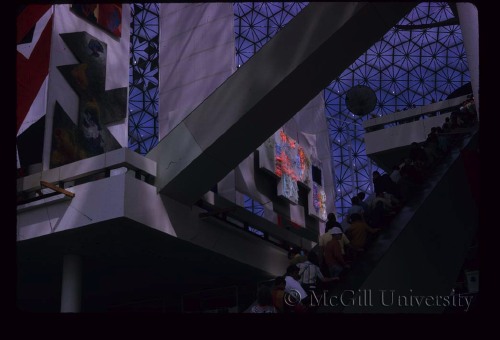
From a 1996 book on Voice of Fire, Barnett Newman's own 17-foot tall contribution, we learn Solomon requested that the artists [all male?] "contribute paintings that are (a) large in scale and (b) vertical in format."
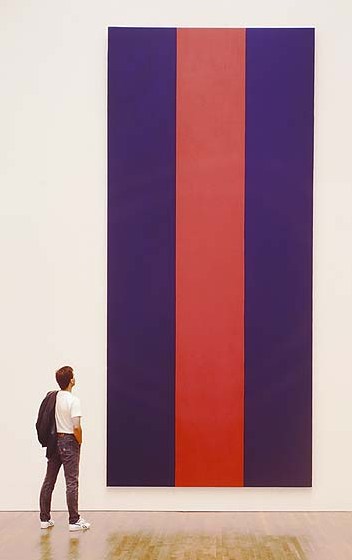 I want to quote "Exorcism in Montreal," the April 30, 1967 review by NY Times critic and famous Newman nemesis John Canaday, in its entirety, but I won't:
I want to quote "Exorcism in Montreal," the April 30, 1967 review by NY Times critic and famous Newman nemesis John Canaday, in its entirety, but I won't:
Here we have the same old clique of names that have been handed the favors regularly in Venice and everywhere else on the circuit. A natural response to the list is "Oh, no, not again!" There is that tiresome Barnett Newman, who this time turns out three vertical stripes in two colors--but they are 17 feet high. There's Jim Dine, with nothing but two big slabs of enameled canvas, in two flat colors, bearing in one corner a notation as to the brand of paint used--and the panels are 35 feet high. There is Roy Lichtenstein being Roy Lichtenstein again, but now 29 feet high.And then there's Canaday's assessment of the NASA artifacts, which basically hits it home for me with the art/science beauty paradox:There are all the rest of the club, not including some whose work was not fully installed on press day, and some whose work seems to me to have more substance than the ones listed, for instance James Rosenquist's colossal "Firepole." I have chosen the most vacuous because in this setting even they are part of a genuinely spectacular show fulfilling demands that could not have been met by any other kind of painting.
The dimensions given above tell that the paintings, most of them done for this spot (what other spot could hold them?), are gargantuan...they are played against strips of sail cloth in heights up to that of a 10-story building. It is as if the whole water-treading esthetic that they represent had been originated and sustained by some genii who knew that one day a form of painting bold enough and shallow enough to supply enormous bright banners for this pavilion would be necessary.
...since technology is creating the most beautiful objects today, and the most imaginative ones, Apollo might also be thought to have added one more muse to the group that he has always chaperoned.Ah, so it's just the domes and the satelloons.Of course, there is no separating the fascination of the Apollo Command Module as a scientific object from its quality as an esthetic one, with its self-generated form and its patina burnt into it during the minutes of its descent rather than by centuries of weather, but it is a beautiful object all the same--inherently beautiful, and no other word than beautiful will do--as well as an historical monument with emotive associations And that is what great works of art used to be.
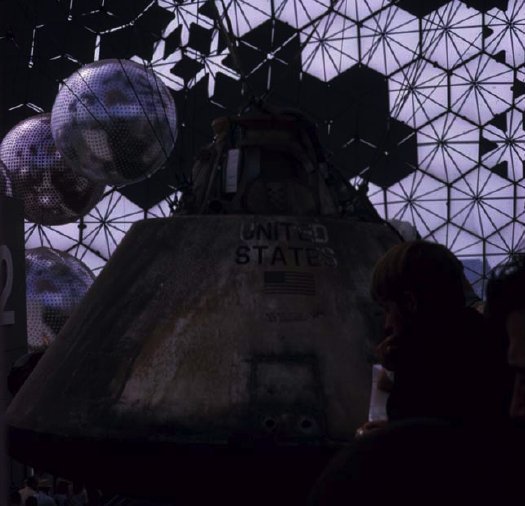
Update: From Architecture & Nature (2003), more details/corrections on who showed what: Kelly had a 30' canvas, no title given. Robert Indiana, Cardinal Numbers. At just 13'x15', Robert Motherwell's Big Painting #2 was anything but. Lichtenstein: Big Modern Painting [sensing a theme here?] Helen Frankenthaler was The Woman Painter. And the Dymaxion Map was by Johns, "a small [sic] token to his friend Fuller's desire to have the map be the centerpiece of the pavilion."
Interior images of Biosphere, the US Pavilion at Expo 67 from The Dixon Slide Collection at McGill University. [mcgill.ca]
Q: was this the Ellsworth Kelly? [no, see update above]
Previously: Hmm. That satelloon & command module show was so good, they used it again at Expo 70 in Osaka.
October 26, 2009
Don't Find The Warhols Yet, Anyway
So it looks like we won't be finding the Warhols just yet. The Kickstarter project deadline came today, and only $265 of the $1400 or so required to print and ship a batch of giant Wanted posters had been pledged. A huge thanks to all the folks who pledged, though; it was and is very encouraging.
This doesn't mean there won't be giant Wanted posters; because frankly, they'd look awesome, and seeing them is at least half the point of the project. The project had to tread a fine, meandering line through that poster awesomeness on the one hand, the unofficial, unsanctioned publishing of the LAPD's poster on the other, and--wait, how many hands do I get?--the obvious intellectual property issues. And of course, underpinning the entire thing is the obvious challenge it poses to our sympathies and sense of value: is it harder or more problematic to feel altruistic and volunteerish towards someone who's lost 11 of his 80-plus Warhol paintings? Is the world actually a worse place because one of eight sets of these portraits is now missing? Did the answers to these questions change after the insurance company's reward was rescinded and Weisman started trashtalking the investigators?
My own interests and motives--to realize and propagate these giant Warhol posters in various back rooms and offices of the art world--still depend on this presumption of a community chipping in and keeping an eye out to help find these missing artworks. It's acting as if the art world is a small subdivision, where everyone joins the search to find the lost puppy. If there's a more hilariously inapt metaphor for the art world than that, I guess I don't know what it is.
Hilary Harris's 1975 Organism feels like a missing link in the chain of film portraits of New York City as a pulsing, living thing. Like Whitman, whose "Leaves of Grass" provided the text for their1921 film Manhatta Paul Strand and Charles Sheeler showed "million-footed Manhattan...descend[ing] to her pavements" and forests of buildings growing up to the sky. Then, by the time Godfrey Reggion made Koyaanisqatsi in 1982, the metaphor was solid enough to use the time-lapse photography Harris pioneered to diagnose the city's terminal illness.
Maybe what modern city life needs to return it to full health is more post offices shaped like mailboxes. I combined frames from the various cuts of Harris's slow, time-lapse pan in order to get a picture of the whole thing. Anyone know where this was?

Watch Manhatta and Organism at Ubu [ubu.com, via brian sholis]
October 22, 2009
Fosse, Gerry. Gerry, Fosse
Bob Fosse as the Snake in Stanley Donen's 1974 movie musical adaptation of The Little Prince [available in low-res original and Billie Jean mashup versions, because why not? via maud]

which was not, in fact, filmed in the same location as Gus Van Sant's Gerry after all:

Related: my 2003 interview with Van Sant's producer Dany Wolf
my idea for a shot-for-shot remake of Gerry set in non-Anglo Los Angeles.
October 22, 2009
Holden Caulfield, Curator
From the Observer profile of Massimiliano Gioni:
Growing up outside Milan in a town he likened to Newark, Mr. Gioni found himself drawn to art precisely because there were no adults talking to him about it. "It didn't belong to the school or the teachers," he said. "It was mine."And from Stranger art critic Jen Graves' review of "Parenthesis," a new show at Western Bridge in Seattle:When he was 14, he started reading the Futurists and the Dadaists--he can still recite by heart Tristan Tzara's Manifesto of Mister Antipyrine--and listening to Sonic Youth, Fugazi, and Dinosaur Jr. He also started looking at the pictures in Artforum and Flash Art, and loving what he saw "because it was so strange."
But when I first read Tristan Tzara's 1918 Dada manifesto in college, as a kid still angry over my parents' messy divorce and the messy new relationships that followed, I was moved by Tzara's childlike claim that "every product of disgust that is capable of becoming a negation of the family is dada." If the family, like art, could not be a strong, safe nest, then it had to be abolished; it's less painful to do away with families than to watch them fail. (Dada was always from the perspective of a disillusioned child.)Either we're in a neo-Dadaist moment right now, or Tzara's Manifestos are the Catcher in the Rye of the art world. [via jason]
October 21, 2009
The Quality Of A Skillfully Executed LeWitt
Yale just held a panel discussion on conservation and artist intention. This kind of thing drives me a little crazy:
Not all work inevitably degrades, though. Some art improves with careful conservation. [Yale University Art Gallery director Jack] Reynolds showed a video of the installation of the massive Sol LeWitt wall drawing show at MASS MoCA. As the audience watched a team wearing paint masks carefully sand a wall, he recalled conditions in Paula Copper's SoHo gallery in 1968, where the artist completed his first wall drawing. "That wall was anything but smooth, unpockmarked, and perfectly sanded," he said. Reynolds also noted that many of LeWitt's draftsmen have specialized in particular techniques, becoming "samurai warriors" in their crafts. A LeWitt skillfully executed today dwarfs the quality of what the artist himself regularly produced. [emphasis added]Really? I mean, really? I guess if that's the way it is, then that's the way it is. But I have to wonder about the implications of this samurai model for the conceptual essence of LeWitt's work. Here's how Holland Cotter described the wall drawings process in his review of Mass MOCA, which was organized with Yale:
It also stays resolutely impersonal, never sticking for long with any single graphic style, never showcasing a distinctive touch, never carrying a signature.So it's an impersonal priesthood?Although LeWitt came up with the initial designs, his relationship to the work was otherwise hands-off. He wrote instructions for how the work should be done -- firm but easy-to-follow recipes with occasional sweeten-to-taste allowances -- but hired other artists to do it. Some he trained, with the expectation that they would train others, who would in turn train still others, stretching on through generations.
For a long time--since the 2000 rerospective at SFMOMA, actually, I've had a secret guerrilla LeWitt show planned in my head, where all the wall drawings are executed by civilians. Just take a catalogue with a bunch of instructions listed in it, and start doing them on the walls. I don't know what that would look like, but for that reason alone, I'm interested to see it.
update: Andrew Russeth, who wrote the original ArtInfo article, just emailed in to claim the "skillful" and "quality" lingo, though I still think he captured the larger point accurately, which is the professionalization and upgraded production values of LeWitt's wall drawings. [Which may be apt for some, especially later bodies of work like the fresco-like geometric shape murals of the 80's and the high-gloss monochromes of the 90's, which were, of course, created in the professionalized era.]
Andrew also mentioned that Dia:Beacon has had a "civilian" LeWitt drawing activity as part of their education program for visiting school groups:
A particular favorite (and one of the most unwieldy titled) with the younger kids was: "3. Wall Drawing #123: Copied lines. The first drafter draws a not straight vertical line as long as possible. The second drafter draws a line next to the first one, trying to copy it. The third drafter does the same, as do as many drafters as possible. Then the first drafter, followed by the others, copies the last line drawn until both ends of the wall are reached. 1972"Which is great to hear, though I'd be more impressed to hear that they put the resulting drawing on public view. Here is Holland Cotter again on the Mass MOCA LeWitts:
Many of his drawings were done by supervised groups of art students -- those at Mass MoCA included -- in a learning-on-the-job tradition very similar to Renaissance workshop practice. A master artist provides the overarching concept; senior artists oversee production; apprentices do the grunt work and in the process discover and develop ideas of their own.So LeWitt's Conceptual Art construct is really just a return to guilds and craft.
The Best of Intentions [artinfo via 16miles]
October 21, 2009
It's So Hard To Get Good Help Finding The Warhols These Days
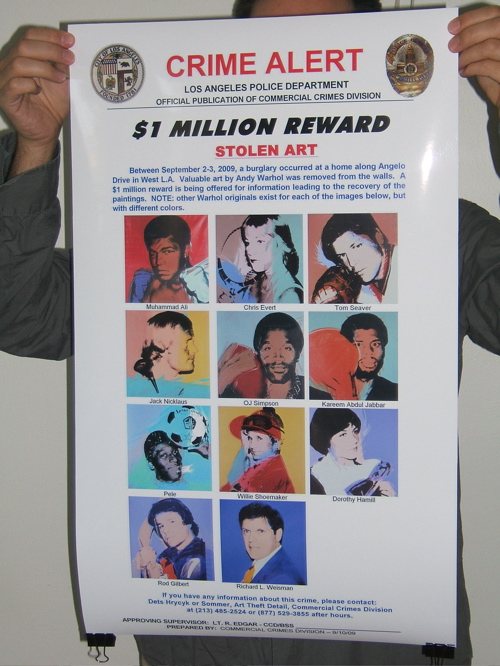
Yeah, well it's like five days until the Find The Warhols! project expires on Kickstarter, and we're still a ways to go from our goal. Normally this would right about the time that a groundswell of sympathy for the victim kicks in, and everyone grabs a couple of posters and hits the streets of Bel Air, trying to find those damn Warhols and bring them home before the storm hits.
A groundswell which might be dampened somewhat by the collector unloading on the LAPD to the LA Times:
Richard L. Weisman, the noted art collector who made news recently when he decided to forgo a multimillion-dollar insurance policy for stolen art, had some critical words for the LAPD detectives investigating his case.Weisman then tiptoed into Pebble Beach Pollock territory with this denial of any involvement in the paintings' disappearance: "The idea that I would steal from myself is the most ridiculous thing I've ever heard.""Maybe if they would do their job ... and spent some time looking for the art instead of being accusatory of the person who had it stolen, they might actually find it," Weisman said in an interview last weekend.
So then you haven't heard about the attempt to crowdsource 500 giant copies of the LAPD's awesome Warhols wanted posters?
Collector who reported Warhol paintings stolen has tough words for LAPD [latimes]
October 20, 2009
Original = Higher Resolution
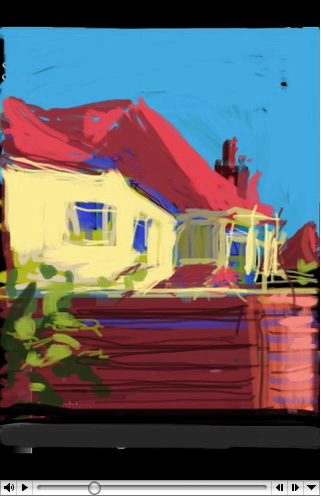 Lawrence Weschler narrates a slideshow of David Hockney's iPhone/Brushes drawings for the NY Review of Books:
Lawrence Weschler narrates a slideshow of David Hockney's iPhone/Brushes drawings for the NY Review of Books:
When he finishes one of these drawings, he sends it out into the world...Technically, there are images and .brushes files. If you send Brushes images as .brushes files, their creation can be replayed like an animated movie. [It makes me interested to try to animate a Brushes work the way, say, William Kentridge does, treating the buildup of strokes as a narrative device. But that's not the point right now.] But if Hockney just sends out images, then his friends have a file that is distinct and different from the "original," and all its embedded generative data. It is certainly different from the image embedded in a slideshow.There's about 15, 20 people, and he assumes that we send them on to other people if we like it.
One of the things that's quite fascinating in this whole thing is that we have the original on our iPhone. Which is to say there's no version that's higher resolution than the one we have; we all have the same resolution. The ones you're looking at right now are originals as well.
But that's a highly particular assumption of originality that pertains to this app. Weschler's assumption that a copy is lower-resolution than an original has much broader implications. It's an assumption that's hardcoded into almost all our image reproduction technology, as I inadvertently discovered when I began trying to accurately reproduce the 300x404 pixels of 300x404, after Untitled (Cowboy) 2003 by Richard Prince, the original of which is a .jpg file.
An image invisibly but irrevocably sheds a phenomenal amount of data and time- and process-related content when it goes from .brushes file to .png or jpg. In precisely the opposite way, transferring 300x404 to anything other than the jpg it is turns out to involve the addition of an incredible amount of data, via interpolation, upgrading and smoothing and blending algorithms. Those original 121,200 pixels get drowned out completely.
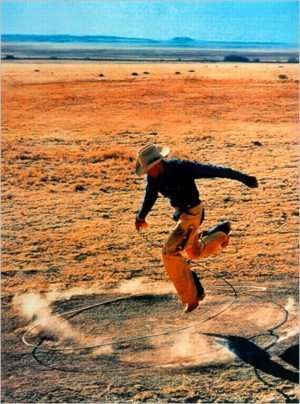
Audio Slide Show: Lawrence Weschler on David Hockney's iPhone Passion [nybooks]
Previously: 300x404: The making of
October 20, 2009
Norton Family Christmas Project At The MoMA Store
Wow. Every Christmas since 1988, Peter Norton and his family have commissioned artists to create a work, which they produced and sent out to friends, family and other art world folks. Now Norton, a MoMA trustee, is emptying out the closet and donating all the extra pieces for sale, with proceeds set to benefit PS1 [Norton was the Chairman of PS1 until just recently. I've helped do fundraising for both MoMA and PS1 for more than 15 years now.]
Anyway, the works are priced from just $45 for the 1990 gift, a CD by Richard Kostelanetz, to $675 [$750 for MoMA non-members] for the 2002 and 2005 gifts, an awesome doll house by Yinka Shonibare and an awesome music box by Christian Marclay, respectively, to $900/$1000 for 1997, Kara Walker's classic silhouette pop-up book. If there's a bargain in the bunch, it's probably 2004, a beautiful glass bowl with molded handprints in the bottom by Do Ho Suh, which is just $225/$250. It's a very MoMA-y, Christmas-y, and well executed gesture.

There are seven other editions, including the very awesome 1998, a blanket by Jim Hodges, that are only available if you buy the "complete set" for $5580/$6200. The quotation marks around "complete set" probably refer to the absence of the 2000 gift, a Mr Pointy figurine by Takashi Murakami, and the 2007 gift, a pair of tricky salt and pepper shakers by Nina Katchadourian.
So whether you're filling in your collection for the years you were on the outs with the Nortons or you want to give a little something back after so many years of getting art free and unbidden in the mail, it's a pretty sweet deal.
The Peter Norton Family Christmas Art Projects editions will go on sale October 28 at 9AM at MoMAstore.org/Norton [momastore.org]
Note to self, the Brazilian media & world's wire services: the guy standing outside his burning house and saying he lost everything does not, in fact, know that everything is lost.
Such is the case with the Projecto Helio Oiticica, where the artists' heirs--his younger brother Cesar and his nephew Cesinha, mostly--have been able to find work that was unharmed in the fire and work that just suffered smoke damage or is otherwise restorable. As Cesinha told the Agencia Estado news service, "When you look at all black, it looks like it's over, but when we opened the boxes scorched, we thinking works. Improved enough yesterday for today (Saturday to Sunday)."
Among the works found already: many of the Metaesquemas series, up to 350 color experiments in gouache on paper or cardboard from 1957-58. At least two bolides monochrome painted objects are intact, and more only need the glass replaced. several big installations are stored downtown at the Centro Municipal Hélio Oiticica. Two of the artist's iconic Parangolés, wearable samba painting/banners, which were all thought to be lost, " were saved by being in an exhibition in Belgium."
Yeah, so those didn't burn up, obviously. So at this point, there's a bit of taking stock, trying to stay positive, a bit of walking back the early over-emotional reactions--and a bit of defensiveness and fingerpointing.
In another Agencia Estado report, Rio's Secretary of Culture Jandira Feghali criticized Cesinha Oiticica directly for the loss of the works: "In my opinion, we lost a collection by a closed attitude of the heir, in particular." She charged Cesinha with pocketing the $US20K/mo the city had been paying the PHO to maintain and conserve the collection, a contract which Rio's new mayor had not renewed.
As Brazilian culture officials deal with the loss of so many works by the country's most important contemporary artist--one whose recent critical reappraisal has mirrored Brazil's own increasing prominence on the global stage--issues of private property and cultural patrimony are coming into play:
According to the secretary, lack a regulatory framework in the country to give better conditions to the giving public access and care for works of dead artists. For current law, works are private property of the heirs of artists and their use requires the permission of them.So even after the smoke clears, there'll still be a heated battle over control of Oiticica's work."My regret is profound, because we tried it any other way. I personally talked to his nephew for us to have the transfer of collection to the Center Hélio Oiticica, for lending. We do not have budget to buy $ 200 million [the estimated value of Oiticica's estate]. They could not give the entire collection, but a part. There must be a new way to deal with it and there is a law," said the secretary.
October 18, 2009
Fire Destroys '90%' Of Helio Oiticica's Work

Unbelievable. The Brazilian artist Helio Oiticica refused to sell his work; his estate, the Projecto Helio Oiticica, held an estimated 95% of his entire output when he died in 1980. The Museum of Fine Arts in Houston had a truly spectacular, history-shaking show of Oiticica's work in 2007, which traveled to the Tate. Roberta Smith said in the Times,
This show is like a large stone dropped into the calm waters of European-American art history. With its thick, lavishly illustrated catalog, it presents an enormously productive artist, writer and thinker whose work effortlessly spans the gap between Modern and Postmodern, Minimal and Post-Minimal. Reflecting inspirations from Mondrian to the samba music of Rio de Janeiro's favelas (slums), it also bridges first- and third-world cultures in a way that has seldom been equaled.Now O Globo reports [via artforum] that a fire in Oiticica's brother's house has destroyed "an estimated 90%" of the PHO's holdings. Some installations and conceptual projects designed to be recreated are fine, of course, but his paintings and sculptures, including his incredible bolides [above], minimalist experiments in experiential color from the early 60s that remind me of Anne Truitt's genre-breaking works, are gone.
Apparently, PHO--which is controlled by the artist's two younger brothers--was in an ongoing dispute with the municipality of Rio over the government's inadequate storage conditions and late exhibition payments for the work. As a result, PHO removed the work to the house--where it just burned up. This just tears me up inside to think about it.
A multi-year digitization project for Oiticica's work and prodigious archives was nearly complete, though, and presumably the 7-volume catalogue raisonne will keep the artist's seminal ideas in circulation. Without the works themselves, though, Oiticica could end up a digital ghost, haunting artists and art historians of the future.
update: O Globo has photos of the aftermath. The loss may be closer to 75%.
The exhibition catalogue for the MFAH show: Hélio Oiticica: The Body of Color [amazon]
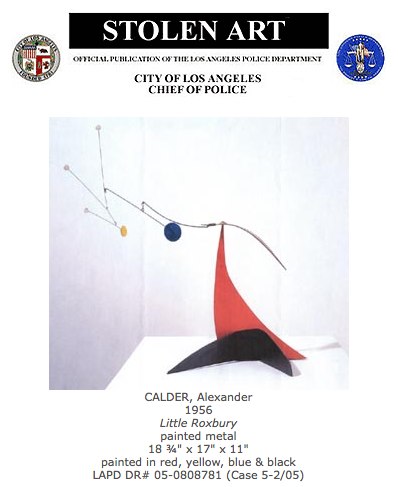
Considering the awesome graphic power of their official publications, you'd think I would have visited the Los Angeles Police Department's Art Theft Detail website sooner. Well, let me make amends:
THE LAPD ART THEFT DETAIL WEBSITE IS FANTASTIC!
Seriously, there is some great art in LA. Or at least there was, until it got JACKED.
Richard Weisman's Warhols may be the biggest art heist of the year--and it definitely has the greatest poster--but just take a look at this small, curated showcase of some of LA's greatest stolen art. If you have seen any of it lately, of course, please contact the LAPD:
The stolen art alerts usually don't mention any circumstances of the theft or the owner. The only clue is the case number, which is usually keyed to the date. Alexander Calder's tabletop stabile, Little Roxbury (1956), [above] was stolen in 2005.
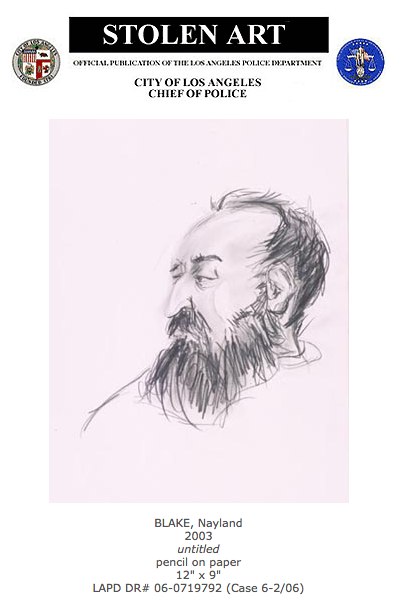
This simple, unassming drawing by Nayland Blake (2003), is just 9x12, small enough to stick in a folder or stack of mail. It was stolen in 2006.
October 17, 2009
On Second Thought, Don't Find The Warhols??

Well that's complicating. Richard Weisman has withdrawn his $25 million insurance claim for the 11 Andy Warhol paintings he reported stolen last month from his home in Los Angeles. As a result, the insurance company, Chartis, has withdrawn its offer of a $1 million reward for the works' recovery.
As the Seattle Times reports,
he simply couldn't stand the thought of insurance investigators poring through his personal records and interrogating his family and friends before he stood any chance of collecting.Uhm, ok! Hrycyk's partner Mark Sommer also said his office had been having a difficult time contacting Weisman about the theft. Mhmm."They turn you into a suspect. I just finally told them, 'I'm not going to go through it for three to five years. Forget it,' " Weisman said. "That's the only reason, and it's a good enough reason."
...
"It's a lot of money he gave up," [LAPD Art Detective Don] Hrycyk said. "It's one of those puzzling aspects you have to take into account when you do your investigation."
Weisman commissioned eight sets of the Athletes paintings in 1977. He has since given away four sets, and has kept a set or two on the market for the last few years. So obviously, he's not short of Warhol Athletes. Bully for him, but what about the rest of us?
While I worried for a second or two, I realized that even without the reward, the Find The Warhols Project is still desperately needed. With so many Warhols out there, it's more important than ever for collectors, traders, and brokers to have a handy reference to check the hotness of their wares.
I assume LAPD will issue a new Wanted Poster [update: they did, for the third time, apparently], but for the FTW! Project, I'm inclined to stick with the original. When posters go out, I will personally add the up-to-date reward information to each work by hand. Just like Thomas Kinkade.
And since Chartis, better known until July as the commercial insurance operation of AIG, is owned by the US government at the moment, taxpayers just saved $1 million - $25 million! It's win-win-win!
Only 10 days left to join the Find The Warhols! Project [kickstarter.com]
See the original Find The Warhols! Project post [greg.org]
October 15, 2009
Deal
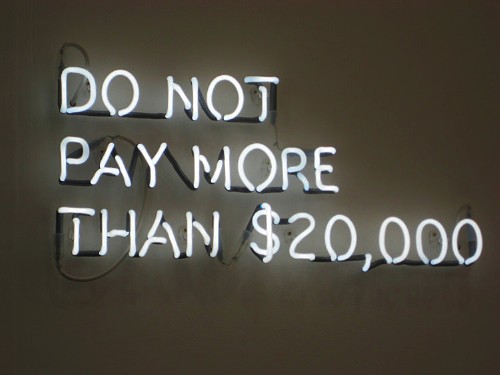
Maybe Jonathan Monk had the same misremembering of Walter de Maria as I did. His series at Lisson Gallery at Frieze comes with various, built-in resale price caps. [via sarah douglas for artinfo]
October 14, 2009
What I Looked At Today - Phillips Edition
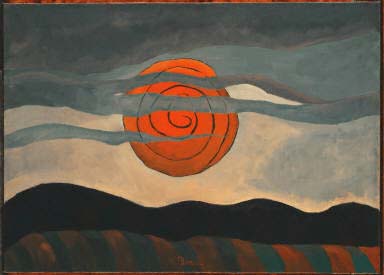
Why, I feel just like Alma Thomas, what with my shopping around for a modernist painting technique to use on my Dutch camo Landscape series...
Anyway, I headed over to the Phillips Collection in search of Arthur Dove paintings. Huge trove, you know; Duncan Phillips was a longtime supporter of the artist and his work. Until yesterday, they had eight Doves up. But they started some work in a gallery, and so today they have just one: Red Sun, 1935, which is hanging in the little half stairway going to the Goh Annex. His line is promising, not nearly as fastidious as the 17th c. Dutch, of course, and thicker paint, which he mixes and blends on the canvas.
A couple of other unexpected pieces made it well worth the trip:
October 14, 2009
There's No Telling What You'll Have To Do
The late, great curator Walter Hopps on his Ferus Gallery in Los Angeles:
Anyway, one of the painters I loved--and I realized that a number of the artists, including [Robert] Irwin, also really loved him--was Giorgio Morandi. No one was showing Morandi in the Westeren United States. I had been traveling, and I came back and discovered that [Irving] Blum had not put an image of Morandi on the invitation. I was really furious. I said, "One in a thousand people who get our invitation will even know who Giorgio Morandi is. We've got to have one of his drawings on this invitation."The interview was originally published in Artforum in 1996, and is included in HUO's interview anthology, A Brief History of Curating.Well, he hadn't had a photographer come in to take a picture. I said: "Clear this desk off. I'm going in the back and choosing a drawing." I picked out a Morandi drawing that was strong enough--it had glass over it--and I laid it down on the table. I took a piece of paper and laid it over the glass, took a soft pencil--and I'm not an artist; Blum would have been better because he can draw--and I traced out that Morandi drawing, to life size, in my own crude version. Traced that son of a bitch out on a blank piece of paper, and I said, "There's the artwork."
Blum said: "You can't do that. You've just made a fake Morandi."
I said: "You watch me do it. You just watch me do it." And that went to the printer, so it's printed in red with its line cut very elegantly on a paper. e waited to see who would identify it as a fake. Never--no one, no one. [Harald] Szeeman is right--there's no telling what you'll have to do.
October 12, 2009
Echo I
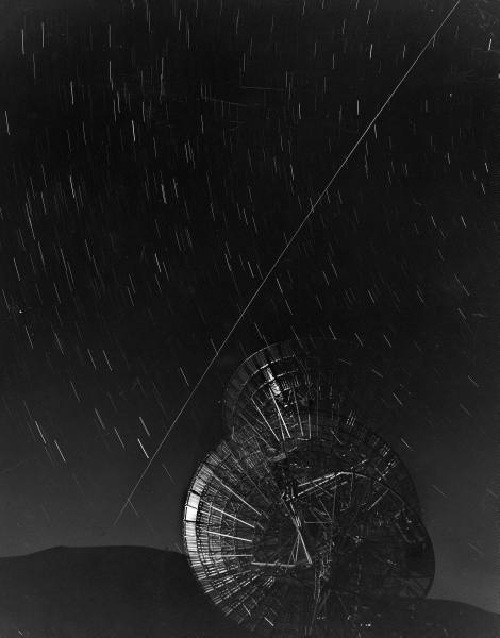
This 1960 LIFE Magazine photo by Grey Villet of Antenna bouncing first message off Echo I satellite is a great, uh, echo of Trevor Paglen's The Other Night Sky series.
October 11, 2009
What I Looked At Today
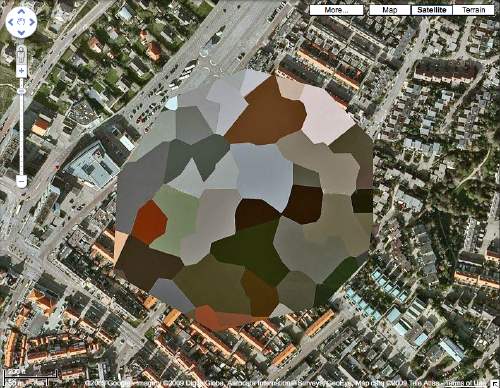
So I decided to make the Dutch landscape paintings I wanted to see made from those incredible security-obscured Dutch Google Maps I found a couple of weeks ago.
I'll print the images out and paint over them. Since they are Dutch landscapes, I figure they'll be nice, little domestic-sized paintings I can make on a table.
I've been trying to puzzle out how to get the paint on there and what it should look like. My first idea was to keep the process as mechanical as possible, both to produce crisp, sharp polygons, but also to mediate between the image and me--and my utter lack of painting experience or technique. But my brother-in-law, an excellent artist with an extraordinary sensitivity to technique and material, made the case for just painting the damn things with a brush.
So I'm convinced, though I'm still not quite settled on how I'll do them. But we set out today to look upclose, extremelyclose, at some 17th century Dutch landscape and cityscape paintings, and see how they were done. Of course, we missed the much-hyped Dutch Cityscapes exhibition at the National Gallery last spring.
Here's what we saw today at the National Gallery:
October 10, 2009
On Wingnuts On Alma Thomas
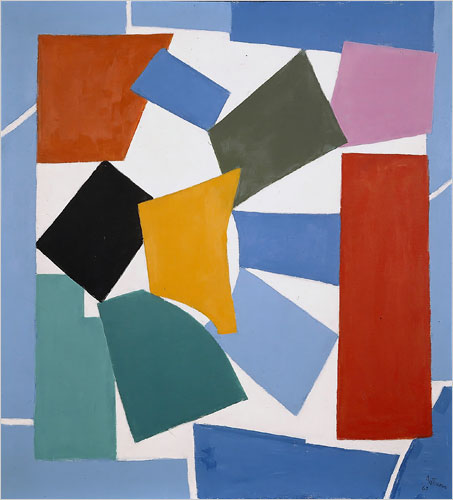
I guess it doesn't matter anymore that I don't see why the White House's art borrowing is news now, when almost the entire list was already published and discussed four months ago [and many weeks before that, too].
Because now some wingnut Know-Nothings have taken it upon themselves to accuse Alma Thomas of plagiarizing Henri Matisse, an act which reinforces their hard-held disdain for the Obamas and anyone and anything associated with them.

It's a false and defamatory claim, and the real story of Thomas and Matisse is deeply fascinating and diametrically opposed to the spiteful, divisive worldview in which it originated. But it didn't seem that useful to just say so.
So I went ahead and read all 200 or so comments on the Free Republic thread where the controversy was born to see if they figured out on their own that Thomas's 1963 painting, Watusi (Hard Edge) [top] was originally created as a deliberate reworking of Matisse's large 1953 cutout collage, l'Escargot [above], and that it had always been recognized and discussed as such by the people who followed Thomas's work.
By around comment #120, they'd at least decided that it was "a study," and that Thomas wasn't a fraud, just a hack. So a small victory for fact buried under an inflammatory and inaccurate headline.
As a hopeless art elitist and documented Obama campaign donor, there's obviously nothing I could ever say that would persuade a hater that the Obamas' choices of art do not, in fact, catch them out as uppity, ignorant, race-hating, affirmative actionist, communist, stalinist, Nazi frauds or whatever.
Look under the hood, though, and the substance of the angry right's criticism of Thomas--and, often enough, frankly, of Matisse--sounds very familiar: specifically, the perceived lack of skill involved in making "modern" art; and Thomas's lack of originality, or more precisely, the rejection of appropriation as a valid artistic strategy.
October 10, 2009
On Knuckleheads On Anne Truitt

I'll have more to say about the incredible work of Anne Truitt in the Hirshhorn's retrospective, thoughtfully curated by Kristen Hileman.
Whether on canvas, paper or sculpture-like wooden armatures, Truitt's exhaustively spare paintings induce, by design, a lot of processing by the viewer. Those interpretations can range from the biographic--reading the works as minimalistic evocations of places, people, and memories from the artist's life; to the flighty-poetic--riffs on whatever sublimity the colors have been up to lately in nature; to the maddening and/or inapt--pronouncements by critics and curators in positions of authority in the art world who you'd expect would know better. I'm starting with the latter.
Truitt was one of critic Clement Greenberg's favorite Minimalists. Unfortunately for her career, that was a bit like being one of George Bush's favorite Democrats. And also? There was this, from Greenberg's 1968 profile of Truitt in Vogue, which Hileman quotes in her catalogue essay:
She certainly does not 'belong.' But then how could a housewife, with three small children, living in Washington belong? How could such a person fit the role of pioneer of far-out art?Besides/because of Truitt's DC isolation, her work was difficult to place in the art world's discourse, which at the time was organized around where you drank: Cedar Bar or Max's Kansas City. Since then, of course. a critical context has developed that can accommodate minimalist abstraction and color and emotion and metaphor and extraordinary process. Which made Hirshhorn chief curator Kerry Brougher's demonstrably wrong characterization of Truitt's art historical significance in his opening remarks at the museum's panel discussion Thursday night all the more baffling.
Brougher described Truitt's work as hugely influential at the time "for Minimalism, Color Field School, whatever you want to call it." I guess it'll all make sense when his definitive catalogue on the Whatever School is published.
And it's shooting fish in a barrel, I know, but I'll end with Washington Post critic Blake Gopnik's flight of sexist goofiness. In one of her books, Truitt skewered Roberta Smith for a condescending, gender-based review of her work. I'd love to hear what the artist would have said about Gopnik, who framed his entire review around the idea that Truitt's human-scaled sculptures are actually mannequins and that her project is somehow transgressive fashion:
This one here could be a matronly Martha Cunningham, clad in forest green but with a stripe of scarlet at her hem to show she's still got spunk. There are the Updike girls, modish in tight-fitting lime and pumpkin and pink. And there's that absurd Mrs. Snyder: She's paired a perfectly nice linen suit with shoes in red and black patent leather.Hahahaha, NO. It is not....
Truitt's best sculptures, even at their most soberly geometrical, tend to "girlish" pastels or fashion brights -- or worse, she mixes the two.
The analogy to fashion seems right. It feels as though Truitt has realized that the so-called "rules" of art are more like fashion etiquette than laws of nature. You imagine that it's simply not possible, dahhling, to wear blue with green -- until the year that some new designer has everybody doing it. If you have the courage to get there first, you'll either make a fool of yourself or be recognized as fashion forward. The truly bold don't care which happens. That's Truitt.
While using show-offy obversion to argue Truitt's significance, Gopnik manages to get Minimalism, Judd, Morris and Truitt wrong, all in one paragraph:
And yet, by the terms of the minimalist movement, Truitt once again turns out to have gotten things wrong. "Real" minimalism was supposed to be absolutely legible and "whole," so you could know a sculpture's essence almost at one glance. At the very least, you were supposed to get a clear "gestalt" of any minimalist sculpture just by walking all around it. Truitt's sculptures often mess that up, by striping each side of an upright in very different colors.Judd was interested in the integrity of the object's shape itself, it had nothing to do with the viewer; he could not have cared less. Gestalt, meanwhile, was Robert Morris's concept for shape, whose "wholeness" could only [not "just"] be understood by the viewer experiencing it from all sides.
For Morris, the issue with color wasn't just uniformity; color was "optical" and "unstable," "inconsistent with the physical nature of sculpture." It thwarted Gestalt [*cough, Judd's anodized metal and tinted plexi *cough*]. But for Truitt, color was the Gestalt. She didn't get Minimalism wrong; she proved it wrong.
My own admiration for Truitt's work arose from her prescient infusion of content into abstracted, minimalist form; I thrilled to discover in her an antecedent to the contemporary artists I came up liking: Gober, Gonzalez-Torres, Horn, Hodges. But the longer I stay with it, and the more I see, the more it feels like a subtle deployment of memory to explore perception and experience. It makes me want to see Truitts alongside works by Ad Reinhardt, James Turrell, Olafur Eliasson, or--moving off the color reservation--even something like Cardiff/Bures-Miller's Forty-Part Motet. Hmm. That's more than I thought I'd have to say.
October 9, 2009
I Am So Banacek, Ch. 2: So Now They're Prints
 I'm really busy Finding The Warhols!, but when the Palm Beach Pollock heist went down, and no one in the crime beat media seemed to know enough about art to spot the inconsistencies and implausibilities in collector/dealer/boytoy Angelo Amadio's claims, I couldn't remain silent.
I'm really busy Finding The Warhols!, but when the Palm Beach Pollock heist went down, and no one in the crime beat media seemed to know enough about art to spot the inconsistencies and implausibilities in collector/dealer/boytoy Angelo Amadio's claims, I couldn't remain silent.
[The biggest red flag, of course, is the couple's claim to have bought or been given an authenticated but secret painting by Jackson Pollock in 2001. But let's set that aside for a moment.]
In all his early statements, Amadio described the stolen works as "paintings." I was the first and only one to point out that the works in the photos were not paintings, but were actually prints: the Miros were lithographs, and the Rembrandt was an etching. As recently as Wednesday, they were being reported as "paintings and drawings."
Now it seems Amadio has agreed with me.
In advance of a press conference scheduled for today, Amadio & co. gave the Monterey County Herald a list of the stolen works, "which include prints by Rembrandt, Renoir and Miro."
Just to be clear: no serious collector, no one who actually owns and handles art, and certainly no one who has been in the "wholesale art business" and authenticating Pollocks for years as Amadio claims would call a print a painting. And they certainly wouldn't do it for Rembrandt, whose paintings and etchings are such completely different physical objects. It'd be like calling a piece of paper a book, or a purse a suitcase. It just makes no sense.
Meanwhile, in other Telling Different Things To Different People news, the LA Times describes Amadio as A law student who clerks for attorney Vicki St. John. Which may be true! Life's complicated, and we all have many different hats and usernames.
Here's what he told the SF Chronicle earlier this week:
Amadio said he is chief executive of Alternative Asset Investments Inc., which he described as a company that deals with artwork. He also said he is a law student, but would not say where.Also this, "St. John's ex-wife is Vicki St. John, who is listed as the attorney for Alternative Asset Investments, Amadio's company, on the firm's Web site."
And from the Herald: "Vicki St. John, an attorney representing Angelo Benjamin Amadio and Dr. Ralph Kennaugh..."
So St. John is Amadio's "boss," his employee, and/or his lawyer. And she's also an ex-wife? Yes, of David St. John, the couple's insurance broker, who is the only other person named so far who claims to have seen the art. In describing the coming "rebuttal press conference" [Amadio & co's term], the LA Times said the collectors' proof would include "a statement from an insurance agent who specializes in art."
So I guess that means the statement will not come from David R. St. John, then, because he apparently specializes in auto, health and life insurance. One of Tulsa's most upstanding independent insurance brokers, I'm sure.
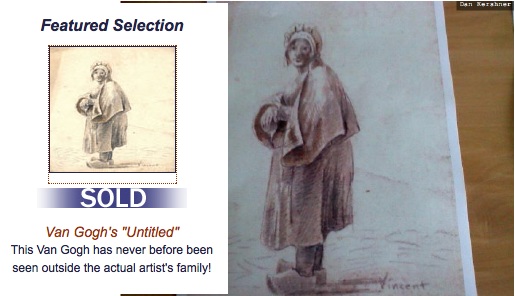
UPDATE: I didn't notice that Wednesday, the Herald put a date on the Pollock: 1944. That should narrow it down.
One work that hasn't gotten any real attention is the Van Gogh. I know, right? Was it the drawing of an old woman [signed "Vincent"] that Amadio showed to KSBW last week? [above, right] Because according to the Internet Archive version of Art Etoile [above, left], Amadio & Kennaugh's defunct "wholesale art" business website, that drawing was "SOLD" for $1.5 million by April 2004. It was described as a "Van Gogh [that] has never before been seen outside the actual artist's family!" What incredible art historical detective skills these guys must have, finding unknown Van Goghs and Pollocks everywhere! Maybe they can help--you guessed it--Find The Warhols!
October 7, 2009
The Modern's Image Of Freedom Competition
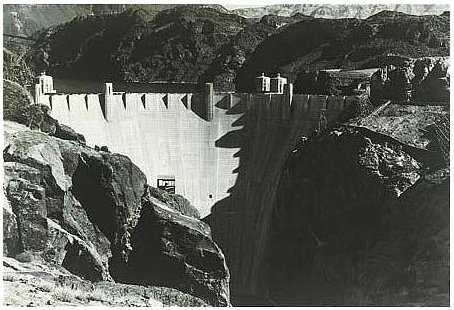
News that the Amon Carter Museum in Fort Worth acquired a painting by Charles Sheeler of the Boulder Dam sent me looking for more, and guess what I found? Sheeler's painting is one of six commissioned in 1938 by Fortune Magazine for a series on "American industrial power." He also made at least 20 photos of the dam, including the print above, which was sold by The Museum of Modern Art in a large sale of photography held at Sotheby's in 2001.
But why stop at pushing the deaccession button, when there's the accession, curatorial stunt, war, and government involvement in the arts buttons to be pushed, too? From the lot description:
This photograph was one of the prize-winning images in the Museum's Image of Freedom contest and exhibition, in which photographers were asked to 'interpret a facet of the American spirit.' Of the 799 photographs entered, 95 were selected as prize- winners and bought by the Museum for $25 each. The photographer's identities were concealed while their entries were reviewed by a judging panel consisting of Ansel Adams, Beaumont and Nancy Newhall, Monroe Wheeler, James Thrall Soby, David McAlpin, Alfred Barr, Jr., and A. Hyatt Mayor.Now truth be told, that's a pretty unimpeachable panel, as far as the history of photography goes. Adams and Barr, you know. Beaumont Newhall helped form MoMA's photography department under trustee/collector McAlpin's watch; Nancy Newhall was an influential critic and close collaborator with Adams and Brett Weston; Wheeler and Soby were both senior officials and/or curators at the Modern as well as trustees; and Mayor was a pioneering print curator at the Met. Still, an anonymous contest where the prize is $25 and entry of your work into the Modern's collection? Would any museum try such a thing today?
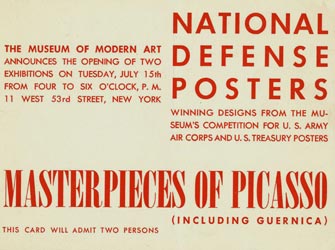
And what about this whole Image of Freedom competition itself? The contest, organized in conjunction with the US Office of Civilian Defense, took place in 1941, before the country actually entered WWII. [The exhibition opened in October, hot on the heels of the National Defense Poster Competition show, part of a double bill with the debut of Picasso's Guernica (above). The goal of this contest was to "urge artists to create posters that would encourage citizens to support the war effort through personal and economic commitment." The posters later appeared in Army recruiting offices and on billboards around the country.]
In the invitation, photographers were asked, "What, to you, most deeply signifies America? Can you compress it into a few photographic images?" and charged to capture "the spirit of our thoughts, our ways, our homes, our jobs." Which doesn't exactly sound the same as our awesome dams, our giant parades, and our suspension bridges [that's one of Brett Weston's award-winners above, which was also sold at Sotheby's].

In his review for Photo Notes, Walter Rosenblum found the Images of Freedom didn't show enough of The People:
Isn't the Image of Freedom something bigger, something more vital [than the natural beauty of the country]? Isn't it that very human quality that differentiates a Nazi Storm trooper from a real American. Isn't it that which is reflected in the workers of Lewis Hine, the people who built the Empire State building, the oppressed who come to this country for refuge?Rosenblum namechecks a few of his favorite Working Man images from the show. Which is all fine, I suppose, though all that union talk sounds like a lot of Ruskie happytalk to me.Isn't it the farmer of Dorothea Lange, the sharecropper's brave wife? Isn't it the complete body of work of the F. S. A.? Isn't it the worker in the mill, in the shop, in the factory? The teacher who can teach as he pleases, without following a regimented text book drawn up by the Nazis? Isn't it reflected in these people who have a stake in our democracy that they are proud of and are willing to fight for to defend?
Isn't it the people who organized Ford at the cost of their lives, the American boys who went to Spain to stop the fascist invader before he was able to spread his power. Isn't it the air raid warden in the city streets, who stands with his head so high, because he is doing his bit for his country? Isn't it that American, who after a hard day's work, visits a Red Cross Station in order to donate his blood to the cause of democracy, to that cause which will give us a better chance of retaining our own freedom.
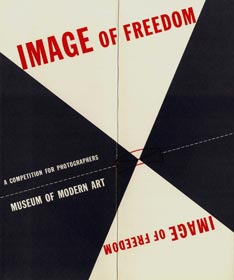 But that discussion still ignores the show's remarkably problematic [or not?] core assumption, namely that a museum--not just a museum, The Museum--should be organizing exhibits for the government and rallying artists to support preparations for war. Or maybe it just baffles me, living as I do in a moment of history where jingoist wingnuts see an NEA conference call as evidence that an army of brainwashing artists is about to enslave America under Obama's tryannical thumb--and where self-important critics make naive, grand pronouncements on the sanctity of Art.
But that discussion still ignores the show's remarkably problematic [or not?] core assumption, namely that a museum--not just a museum, The Museum--should be organizing exhibits for the government and rallying artists to support preparations for war. Or maybe it just baffles me, living as I do in a moment of history where jingoist wingnuts see an NEA conference call as evidence that an army of brainwashing artists is about to enslave America under Obama's tryannical thumb--and where self-important critics make naive, grand pronouncements on the sanctity of Art.
How does MoMA account for its own deep, involved history of colloboration with the government to produce exhibitions and to promote The American Way or whatever? The short answer is with careful ambivalence that tries to distinguish, at least in retrospect, the independently artistic from the overtly propagandistic. Here's the introduction to an exhibition in the Museum Archive called, "The Museum and The War Effort: Artistic Freedom and Reporting for 'The Cause,'" organized last year by two folks in the Archive, Miriam Gianni and MacKenzie Bennett:
In the United States in the 1930s and the early 1940s, many people believed that modern art could pave a pathway to democracy. Numerous exhibitions at The Museum of Modern Art were produced in collaboration with the United States government. The Museum also continued to organize shows that were aligned with its mission to exhibit the best of recent works of art.Weston's images were included in a collection survey in 1944, but Sheeler's photo was apparently never exhibited again by the Museum. It makes me wonder how other Image of Freedom winners fared after the war, artistically speaking, I mean. Maybe despite its long history as an official partner of government propaganda, the Modern has managed to keep its independent artistic and curatorial efforts clear of interference from The Man. Just like how a fine art photographer keeps her commercial work separate from her art.Artists in the United States, Europe, and Asia used art as a medium through which they could voice their opinions about political regimes, war, and social turmoil. From 1938 onward, a variety of compelling exhibitions featuring works produced by artists motivated by wartime experiences were organized at the Museum. In Luis Quintanilla: An Exhibition of Drawings of the War in Spain, Art from Fighting China, and Yank Illustrates the War, MoMA provided its public with a glimpse into war-torn Europe and Asia and an inside look at the difficulties of military life.
In addition to exhibiting war-focused artworks, the Museum played an active role in seeking out artists to assist in government campaigns for the war effort. Staff from the Museum acted as liaisons between government agencies and artists. In 1942 James Thrall Soby became director of the Museum's Armed Services Program, which functioned as an intermediary between government agencies and the Museum. Under its auspices, exhibition and film programs designed to rally support for the war and solidify America's image as a society interested in spreading democracy and freedom were added to MoMA's roster.
Or maybe that's exactly what they want you to think.
So first the big news about the Pebble Beach Pollock Caper: did I call it or what? The Monterey Herald reports from the Sheriff's Dept. press conference today that Angelo Amadio and Ralph Kennaugh are now being considered suspects in, well, if it's not an actual $80 million art theft, it's some kind of "criminal enterprise." They've hired a defense attorney, but they have not, as yet, provided the police with any actual documentation that proves the supposedly stolen works even exist.
David St. John says it exists, though. He's supposedly the collectors' insurance broker [and his ex-wife is listed as counsel for Amadio's newly incorporated investment company, so a really arm's length guy. From the SF Chronicle:
David St. John said he had seen his clients' most valuable painting, an untitled Pollock that police were told was worth $20 million.Ah, now we're getting somewhere. A 4x7-foot Pollock which has traded hands three or four times in 50+ years, yet has never been sold or exhibited publicly. A painting which is not in the four-volume, 1978 catalogue raisonne or the supplement, yet is "known amongst Pollock collectors," Amadio "thinks.""There have been very few owners - three or four as I can trace," Amadio said. "It's known amongst Pollock collectors, I think."
I guess I've just been spending too much time trying to rally all the Warhol collectors to Find The Warhols! to do much Pollock collector outreach. Could someone who's on Facebook contact the Pollock Collectors Group for me and tell them to spill the beans?
UPDATE: Watch the raw feed of the Sheriff's bemused press conference! [kcra.com]
Also, the Google Map and the real estate listing for the scene of the as-yet-unspecified crime: $4.3m, not $5m, and flooded with western light. Good thing the prints were all rolled up!

October 5, 2009
What Do People Do With Their Google Voice Numbers?
I took two main factors into account when I signed up for Google Voice:
I know it's old-fashioned, but I wanted the area code's geography to have some significance.
I wanted something catchy, brand-y, not just easy to remember, but worth remembering. My name, URL, etc. would have been ideal, but if not, then some usefully meaningful word or phrase would do.
Which is how I ended up with 34-SOUVENIR. 347 is a New York City area code, of course, but SOUVENIR was just about the longest word I could generate with the 10-digit numbers in Google's pot. And it happens to have a nice resonance with my first short film series. And it happens to mean "remember" in French, so it's built right in!
Now I just need to figure out what to do with it. Any thoughts or suggestions? Give me a call.
October 4, 2009
Oh, You Mean From The Dead Coke Fiend Pollock Hoard
Now that the Monterey Herald's on the case, I think the Pebble Beach Pollock heist will be wrapped up pretty soon. Then we can get back to Finding The Warhols! Out of Angelo/Benjamin Amadio's shifty, grifty interview with reporters Larry Parsons and Julia Reynolds, emerge details about the stolen Pollock and the "wholesale" art business Amadio ran for ten years:
A few minutes later, Amadio confessed that he knows "nothing about art." But his role in the partnership with Kennaugh was "find it, buy it and sell it." And he said he has good connections in the art world.Ah, so in 2001, when he was 23, the guy who knows "nothing about art" authenticated an unknown hoard of purported Pollocks, and got "one of the real Pollocks" he identified as a thank you gift.In 2001, Amadio said, research he did for a big-time art broker involved in the pending sale of a lot of Pollock paintings revealed that some of them weren't authentic.
In gratitude, he said, a would-be buyer gave the men one of the real Pollocks -- the same one they now say was taken from an upstairs office nook, where it was rolled up for storage. The broker, he said, wound up dying, an art world casualty of "cocaine overdose out West," he said [from his rental house perched on the West coast]."
Who was this coke-snorting, big-time Pollock broker out West? I'm sure he must be very well-known to the Pollock-Krasner Foundation. Just think of the firestorm of attention and debate that erupted in 2005 when sexploitation filmmaker Alex Matter, whose parents were friends of the Pollock-Krasners, pulled a stack of small purported Pollocks from his late father's East Hampton storage unit. [below: a NYT photo of Matter with some of his find.]
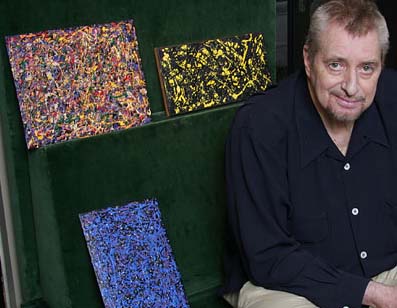
In fact, much of the story of the Matter Pollocks unfolds in Boston, where Amadio lived with his partner, Harvard physician Dr. Ralph Kennaugh. The NY Times reported in 2007 that pigments from Matter's paintings were analyzed at the Harvard Art Museums and the MFA. When the pigments were found to have been manufactured long after the artist's death in 1956--some as recently as 1996, after even Matter's father's death--Matter disputed the findings, and then commissioned a do-over in Williamstown, and then threatened to sue that guy over the results. And the whole trove was exhibited later that year at Boston's College's McMullen Museum.
Oh, look, as coverage of the local angle on the Matter paintings controversy picked up in 2007, the Boston Globe's Geoff Edgers got Matter to admit that he had given "partial ownership" of his Pollock stash to dealer Ronald Feldman in exchange for help covering the "expenses associated with restoring, insuring and researching the works."
So it could totally happen! Matter actually said he found the works in 2002. There are 22 canvases and 10 boards. Maybe he gave one of the largest canvases to Amadio for helping him clean out the storage unit, and kept the tiny, notebook-sized ones himself? [Q: Did Alex Matter OD in the desert recently?]
Of course, right in the middle of this Matter matter, David Geffen reportedly sold his Pollock painting, No. 5, 1948, for $140 million. That painting measures 4x8 feet, very close in size to Amadio's Pollock. No. 5 is on fiberboard, though, not so easy to roll up and store behind your printer. To a collector-dealer of Amadio's savvy and renown, I'm sure such a confluence of Pollock stories unfolding in his own backyard was a purely matter of deep, scholarly interest--and not a blueprint for concocting a giant Pollock scam of his own.
Pebble Beach art heist puts collectors in spotlight [montereyherald.com]
October 2, 2009
Cherchez La Femme [Qui Pisse]
Stolen art aficionados, please don't let the reports of a giant $60 million art theft in Pebble Beach distract us from Our Important Task of Finding The Warhols, because it is a big gay hoax. I'll bet you a Warhol wanted poster.

Every thing about the Pebble Beach heist is fishy or inconsistent or hilariously a lie. Let's start out with the collectors themselves, A. Benjamin Amadio, 31 and Dr. Ralph Kennaugh, 62, who present themselves as business partners. Business partners who lived together, retired from Boston together, and were renting the $5 million house with no alarm system while either finishing construction on their new place or shopping around for a place to build. They first went into business together 10 years ago, when Amadio, then 21, was either an art gallerist or a venture capitalist in Ohio.
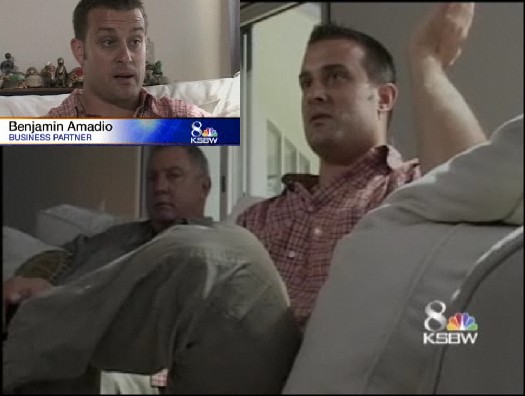
A. Benjamin is better known to Google as Angelo Amadio, and as 40 commenters at the Boston Herald--but no reporter anywhere so far--were able to figure out, he is the subject of numerous ripoff complaints for selling undocumented puppies as AKC-registered, but then never delivering the paperwork.
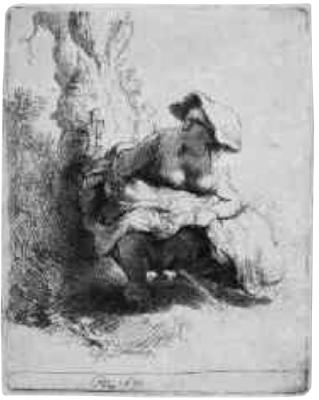
But what about the art? From the Boston Globe:
Amadio said that only three or four people in the world knew the two owned some of the pieces and that the thieves took only authenticated paintings, though the collection included some impeccable reproductions that only a skilled eye would be able to distinguish from the original.Among those "authenticated paintings" were irreplaceable works by Rembrandt, Van Gogh, Miro, Matisse, Renoir, Jackson Pollock, and G.H. Rothe."When they hit us, they knew exactly what they were looking for,'' he said.
"They knew exactly where they were and the difference between some of the authentic pieces and some of the reproductions.''
Ignore for a moment that G.H. Rothe is a gigantic print mill, cranking out tens of thousands of pastel posters of taut ballet dancers and running horses--both of which were prominent subjects in the Amadio-Kennaugh "theft" and any of which could be easily replaced for a couple hundred impulsively spent bucks on your next Carnival Cruise.
As for the "real" artists' paintings, the Rembrandts are clearly etchings. One, Femme qui pisse, or Woman making water, is either the version offered for sale in this 2005 CG Boerner catalogue [PDF, image above] or the shabbier one they mention which was sold at auction. It's hard to tell from Amadio's blurry color copy documentation of this extremely rare and priceless treasure. And the Miros are clearly prints, too. [The one on the left is reproduced pointing down the Herald, and up in KSBW's story.]

The biggest tell, though, is the Pollock, the only painting mentioned which could justify the $27 million, $60 million, or $80 million values Amadio has claimed. It is 4x7 feet. There is no published image of it. They supposedly bought it in 2001. It has supposedly never been exhibited or on the market publicly. The only thing that can be said with certainty about this purported Pollock is that it is not the #$&% Jackson Pollock bought by trucker Teri Horton in 1992 for $5, which was the subject of the 2006 joke documentary, Who the #$&% Is Jackson Pollock? As you can see from the movie poster, that #(*$% Pollock is more than four feet tall:
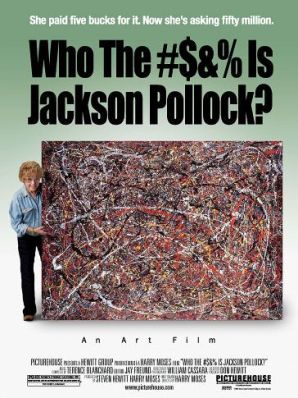
Also, the insurance talk doesn't make sense [it costs $30 million to insure a collection supposedly appraised by the insurance company for $27 million?]; the local law enforcement discrepancies; the lack of FBI Art Theft Division involvement; the sudden appearance of a ransom note/death threat? It's all too much to believe with a straight [sic] face. And yet it gets reported far and wide by newspaper and TV sources as unquestioned fact.
I give it less than a week before the whole Pebble Beach caper implodes in a cloud of boytoy blackmail gone awry. [c-monster]



